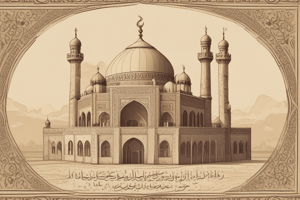Podcast
Questions and Answers
Who pioneered the study of algebra and wrote a textbook that became the defining authority on the subject for hundreds of years?
Who pioneered the study of algebra and wrote a textbook that became the defining authority on the subject for hundreds of years?
- An Indian mathematician
- A Muslim mathematician (correct)
- A Greek philosopher
- An Italian scholar
Which scholar first introduced Arabic numerals to Europe through a publication in 1202?
Which scholar first introduced Arabic numerals to Europe through a publication in 1202?
- An Indian astronomer
- An Italian mathematician (correct)
- A Roman historian
- A Chinese mathematician
What system is commonly used by the developed world today for writing numbers?
What system is commonly used by the developed world today for writing numbers?
- Chinese characters
- Mayan numbers
- Roman numerals
- Arabic numerals (correct)
Which numeral system significantly improved upon the Roman numeral system?
Which numeral system significantly improved upon the Roman numeral system?
Who recognized the superiority of Arabic numbers over the Roman numeral system?
Who recognized the superiority of Arabic numbers over the Roman numeral system?
What discipline did other mathematicians pursue apart from algebra in Islamic scholarship?
What discipline did other mathematicians pursue apart from algebra in Islamic scholarship?
Which mathematical system was used by Islamic scholars alongside pursuing geometry and trigonometry?
Which mathematical system was used by Islamic scholars alongside pursuing geometry and trigonometry?
What was perhaps the most significant Islamic contribution to the West in the field of mathematics?
What was perhaps the most significant Islamic contribution to the West in the field of mathematics?
Who recognized the significant improvement of Arabic numbers over the Roman numeral system?
Who recognized the significant improvement of Arabic numbers over the Roman numeral system?
Which scholar's textbook became the defining authority on algebra for hundreds of years?
Which scholar's textbook became the defining authority on algebra for hundreds of years?
Who was credited with pioneering the study of algebra?
Who was credited with pioneering the study of algebra?
Which numeral system is commonly used by the developed world today for writing numbers?
Which numeral system is commonly used by the developed world today for writing numbers?
What system did Islamic scholars alongside algebra pursue in their mathematical studies?
What system did Islamic scholars alongside algebra pursue in their mathematical studies?
Which scholar introduced Arabic numerals to Europe through a publication in 1202?
Which scholar introduced Arabic numerals to Europe through a publication in 1202?
Flashcards are hidden until you start studying
Study Notes
The Golden Age of Islam
- Islamic scholars contributed to the development of many fields, including art, literature, science, and medicine, during the Abbasid caliphate (750-1258 CE).
- The House of Wisdom in Baghdad was a center of learning where scholars from diverse backgrounds gathered to preserve and advance knowledge.
Arts and Literature
- Islamic art discourages human figure depiction, leading to the development of unique decorative elements, such as calligraphy, geometric designs, and arabesques.
- The art of glassblowing was perfected, and miniature paintings adorned glass, silver, brass, and ivory objects.
- Manuscripts were written in calligraphy and illuminated, and royal robes featured lavish embroidery.
- The Dome of the Rock in Jerusalem, built in 691 CE, is a prime example of Islamic architecture, combining domes, arches, and calligraphy.
- Islamic scholars translated classical works from China, India, and Greece into Arabic, preserving knowledge for future generations.
- The House of Wisdom enabled the production of literary achievements, such as One Thousand and One Nights, and the adaptation of folk tales from around the empire.
Science and Medicine
- Islamic scholars excelled in astronomy, studying ideas from Greece, Iran, and Persia to improve scientific instruments, like the astrolabe.
- They refined methods for recording scientific observations, leading to accurate calculations for the movements of the sun, moon, and planets.
- Islamic scholars analyzed Ptolemy's model of the universe, studied eclipses, and calculated the circumference of the earth.
- Medical achievements included the development of hospitals with emergency rooms, surgical facilities, and attention to hygiene and sanitation.
- The Canon of Medicine, written by Avicenna, became a authoritative medical textbook in Europe for over 500 years.
- Pharmacology emerged as a separate discipline, with achievements such as mixing sweet syrup with bitter medicine and developing anesthesia.
Studying That Suits You
Use AI to generate personalized quizzes and flashcards to suit your learning preferences.




